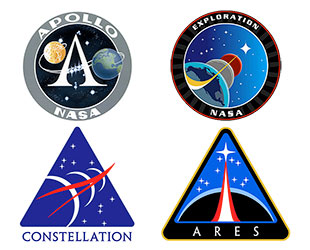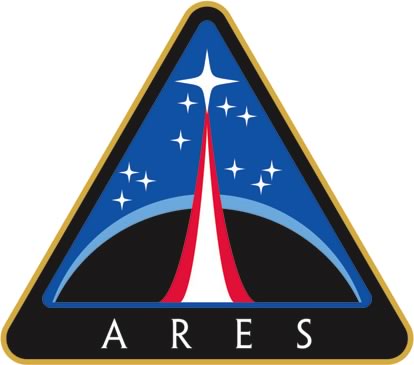Neues Mondprojekt der NASA hat einen neuen Namen
22. August 2006
Heute wurde es offiziell: Das neue Crew Exploration Vehicle (CEV) und
Mondlandeprogramm der NASA wird den Namen Orion tragen. Der Name
der Raumkapsel wurde versehentlich vor der offiziell geplanten
Veröffentlichung von dem im All befindlichen Astronauten Jeff Williams
bekanntgegeben (mehr dazu im CNN-Bericht weiter unten).
Auch ein Emblem, das den Namen ORION trägt, ist in einem NASA
internen Dokument schon gesehen worden.


Das dreieckige Emblem, das der Form der neuen Mannschaftskapsel
ähnelt, hat einen blauen Hintergrund und weiße Sterne, die das Sternbild
Orion darstellen.
Das Orion Projekt der NASA, wird jeweils 4 - 6 Astronauten an Bord der
Orion Kapsel mit sich führen.
Das Raumschiff wird die Erde umkreisen, dann zur Internationalen
Raumstation und später zum Mond fliegen.
Wer den Zuschlag zum Bau des CEV bekommen wird, ist noch nicht
entschieden.
Zwei Teams, eins, angeführt von Lockheed und dem anderen eine
Gemeinschaftsarbeit von Northrop Grumman und der Boeing Co.,
kämpfen gegenwärtig darum das CEV zu bauen.
Es wird erwartet, dass die NASA den Gewinner am 31. August bekannt gibt.
Spaceman spills the beans
22 August 2006
CNN.com
CAPE CANAVERAL, Florida (AP) -- The name of the new vehicle that NASA
hopes will take astronauts back to the moon was supposed to be
hush-hush until next week.
But apparently U.S. astronaut Jeff Williams, floating 220 miles above Earth
at the international space station, didn't get the memo.
Williams let it slip Tuesday that the new vehicle's name is Orion.
"We've been calling it the crew exploration vehicle for several years, but
today it has a name -- Orion," Williams said, taping a message in advance
for the space agency that was transmitted accidentally over
space-to-ground radio.
NASA planned to reveal the new name August 31, when the space agency
also announces which contractor will build the vehicle. Competing for the
award are Lockheed Martin and a team made up of Northrop Grumman
and Boeing.
The crew exploration vehicle will replace the space shuttle program after
it ends in 2010. Earlier this summer, NASA announced the names of the
rockets that will propel the crew exploration vehicle and a cargo vehicle,
respectively Ares I and Ares V.
NASA spokesman Michael Braukus in Washington said the space agency
has been looking at several names and that nothing was official until the
formal announcement next week.
"My next phone call is to Houston asking, 'What's going on?"' Braukus said.
Quelle: CNN.com
NASA Names New Crew Exploration Vehicle Orion
22 August 2006
NASA.gov
NASA announced Tuesday that its new crew exploration vehicle will be
named Orion.
Orion is the vehicle NASA’s Constellation Program is developing to carry a
new generation of explorers back to the moon and later to Mars. Orion will
succeed the space shuttle as NASA's primary vehicle for human space
exploration.
Orion's first flight with astronauts onboard is planned for no later than
2014 to the International Space Station. Its first flight to the moon is
planned for no later than 2020.
Orion is named for one of the brightest, most familiar and easily
identifiable constellations.
"Many of its stars have been used for navigation and guided explorers to
new worlds for centuries," said Orion Project Manager Skip Hatfield. "Our
team, and all of NASA - and, I believe, our country - grows more excited
with every step forward this program takes. The future for space
exploration is coming quickly."
In June, NASA announced the launch vehicles under development by the
Constellation Program have been named Ares, a synonym for Mars. The
booster that will launch Orion will be called Ares I, and a larger heavy-lift
launch vehicle will be known as Ares V.
Orion will be capable of transporting cargo and up to six crew members to
and from the International Space Station. It can carry four crewmembers
for lunar missions. Later, it can support crew transfers for Mars missions.
Orion borrows its shape from space capsules of the past, but takes
advantage of the latest technology in computers, electronics, life support,
propulsion and heat protection systems. The capsule's conical shape is the
safest and most reliable for re-entering the Earth’s atmosphere, especially
at the velocities required for a direct return from the moon.
Orion will be 16.5 feet in diameter and have a mass of about 25 tons.
Inside, it will have more than 2.5 times the volume of an Apollo capsule.
The spacecraft will return humans to the moon to stay for long periods as
a testing ground for the longer journey to Mars.
NASA's Johnson Space Center, Houston, manages the Constellation
Program and the agency's Marshall Space Flight Center, Huntsville, Ala.,
manages the Exploration Launch Projects' office for the Exploration
Systems Mission Directorate, Washington.
Quelle: NASA.gov
The New Logos

The Orion logo is the fourth to be associated with NASA's new exploration
program. Prior insignias have included a design for the agency's Office of
Exploration Systems, a Constellation Program emblem and, as was
revealed in June, a logo for Project Ares, the rockets that will launch Orion
and its lunar lander.
NASA's first lunar landing program, Apollo used a circular emblem that
featured an enlarged "A". The letter's cross stroke was formed by the
three stars of the constellation Orion.
Quelle: collectspace.com
+ View Expanded Views of Ares I and Ares V (1.3 Mb PDF)
NASA TV
Wikipedia: Project Constellation
Wikipedia: Ares I und V (Raketen)
Wikipedia: Orion-Raumschiff (CEV)
22. August 2006
Heute wurde es offiziell: Das neue Crew Exploration Vehicle (CEV) und
Mondlandeprogramm der NASA wird den Namen Orion tragen. Der Name
der Raumkapsel wurde versehentlich vor der offiziell geplanten
Veröffentlichung von dem im All befindlichen Astronauten Jeff Williams
bekanntgegeben (mehr dazu im CNN-Bericht weiter unten).
Auch ein Emblem, das den Namen ORION trägt, ist in einem NASA
internen Dokument schon gesehen worden.


Das dreieckige Emblem, das der Form der neuen Mannschaftskapsel
ähnelt, hat einen blauen Hintergrund und weiße Sterne, die das Sternbild
Orion darstellen.
Das Orion Projekt der NASA, wird jeweils 4 - 6 Astronauten an Bord der
Orion Kapsel mit sich führen.
Das Raumschiff wird die Erde umkreisen, dann zur Internationalen
Raumstation und später zum Mond fliegen.
Wer den Zuschlag zum Bau des CEV bekommen wird, ist noch nicht
entschieden.
Zwei Teams, eins, angeführt von Lockheed und dem anderen eine
Gemeinschaftsarbeit von Northrop Grumman und der Boeing Co.,
kämpfen gegenwärtig darum das CEV zu bauen.
Es wird erwartet, dass die NASA den Gewinner am 31. August bekannt gibt.
Spaceman spills the beans
22 August 2006
CNN.com
CAPE CANAVERAL, Florida (AP) -- The name of the new vehicle that NASA
hopes will take astronauts back to the moon was supposed to be
hush-hush until next week.
But apparently U.S. astronaut Jeff Williams, floating 220 miles above Earth
at the international space station, didn't get the memo.
Williams let it slip Tuesday that the new vehicle's name is Orion.
"We've been calling it the crew exploration vehicle for several years, but
today it has a name -- Orion," Williams said, taping a message in advance
for the space agency that was transmitted accidentally over
space-to-ground radio.
NASA planned to reveal the new name August 31, when the space agency
also announces which contractor will build the vehicle. Competing for the
award are Lockheed Martin and a team made up of Northrop Grumman
and Boeing.
The crew exploration vehicle will replace the space shuttle program after
it ends in 2010. Earlier this summer, NASA announced the names of the
rockets that will propel the crew exploration vehicle and a cargo vehicle,
respectively Ares I and Ares V.
NASA spokesman Michael Braukus in Washington said the space agency
has been looking at several names and that nothing was official until the
formal announcement next week.
"My next phone call is to Houston asking, 'What's going on?"' Braukus said.
Quelle: CNN.com
NASA Names New Crew Exploration Vehicle Orion
22 August 2006
NASA.gov
NASA announced Tuesday that its new crew exploration vehicle will be
named Orion.
Orion is the vehicle NASA’s Constellation Program is developing to carry a
new generation of explorers back to the moon and later to Mars. Orion will
succeed the space shuttle as NASA's primary vehicle for human space
exploration.
Orion's first flight with astronauts onboard is planned for no later than
2014 to the International Space Station. Its first flight to the moon is
planned for no later than 2020.
Orion is named for one of the brightest, most familiar and easily
identifiable constellations.
"Many of its stars have been used for navigation and guided explorers to
new worlds for centuries," said Orion Project Manager Skip Hatfield. "Our
team, and all of NASA - and, I believe, our country - grows more excited
with every step forward this program takes. The future for space
exploration is coming quickly."
In June, NASA announced the launch vehicles under development by the
Constellation Program have been named Ares, a synonym for Mars. The
booster that will launch Orion will be called Ares I, and a larger heavy-lift
launch vehicle will be known as Ares V.
Orion will be capable of transporting cargo and up to six crew members to
and from the International Space Station. It can carry four crewmembers
for lunar missions. Later, it can support crew transfers for Mars missions.
Orion borrows its shape from space capsules of the past, but takes
advantage of the latest technology in computers, electronics, life support,
propulsion and heat protection systems. The capsule's conical shape is the
safest and most reliable for re-entering the Earth’s atmosphere, especially
at the velocities required for a direct return from the moon.
Orion will be 16.5 feet in diameter and have a mass of about 25 tons.
Inside, it will have more than 2.5 times the volume of an Apollo capsule.
The spacecraft will return humans to the moon to stay for long periods as
a testing ground for the longer journey to Mars.
NASA's Johnson Space Center, Houston, manages the Constellation
Program and the agency's Marshall Space Flight Center, Huntsville, Ala.,
manages the Exploration Launch Projects' office for the Exploration
Systems Mission Directorate, Washington.
Quelle: NASA.gov
The New Logos

The Orion logo is the fourth to be associated with NASA's new exploration
program. Prior insignias have included a design for the agency's Office of
Exploration Systems, a Constellation Program emblem and, as was
revealed in June, a logo for Project Ares, the rockets that will launch Orion
and its lunar lander.
NASA's first lunar landing program, Apollo used a circular emblem that
featured an enlarged "A". The letter's cross stroke was formed by the
three stars of the constellation Orion.
Quelle: collectspace.com
+ View Expanded Views of Ares I and Ares V (1.3 Mb PDF)
NASA TV
Wikipedia: Project Constellation
Wikipedia: Ares I und V (Raketen)
Wikipedia: Orion-Raumschiff (CEV)



























Kommentar